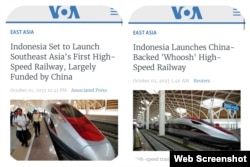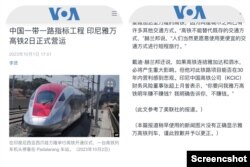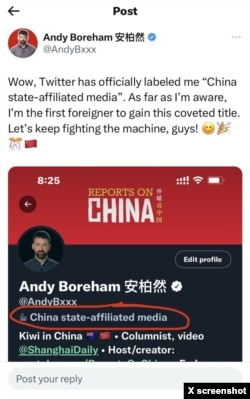Indonesian President Joko Widodo inaugurated the country’s first high-speed railway on October 2. The 7.3 billion project is backed by the People’s Republic of China trillion-dollar Belt and Road Initiative.
The Whoosh high-speed railway connects Jakarta with Bandung, the capital of West Java province, cutting travel time from three hours to 40 minutes, Voice of America reported Monday.
But on X, formerly Twitter, some pro-PRC users shared a picture of what they presented as a screenshot of the VOA’s report about the railway, which was illustrated with a picture of China’s GMC-48JS duel-powered rail track grinding train instead of the futuristic-looking Whoosh high-speed railway train.
Nik Stankovic, the X user who posted the original “screenshot,” speculated that VOA intentionally used a picture of the older and less advanced rail track in its report about the Whoosh railway:
“Voice of America chose this image to accompany the story about the beginning of official operation of BRI train in Indonesia.”
That claim is misleading.
Voice of America’s news center reports are illustrated with the proper image of the Whoosh high-speed railway.
Stankovic's “screenshot” was altered with the English language headline from the reports in Mandarin and Cantonese languages.
Moreover, Stankovich’s implication that the choice of the old image was VOA’s editorial decision is false.
Voice of America’s Mandarin and Cantonese editors told Polygraph.info that they did initially use a wrong image in their website reports due to human error. The images have been immediately replaced upon discovery of the error and editors’ notes were added to both reports to reflect the correction.
As a news piece, it did not involve an editorial decision as Stankovic claimed.
Andy Boreham, another pro-China influencer, quoted Stankovic’s post with his own picture standing in front of a Whoosh train. Boreham claimed that Stankovic’s fabricated “screenshot” was “typical fake news from the West.”
Andy Boreham is a New Zealander living in Shanghai and a columnist for the Chinese state media Shanghai Daily. Boreham runs his own channel on YouTube called Reports on China, which promotes anti-American sentiments and views aligned with the Chinese government.
A recent video of his travel on the China-Laos railway was titled “Laos Railway: America bombs, China builds.” The other, a video commentary on Huawei’s new Mate 60 Pro smartphone was titled “Game over for U.S. chip sanctions?!”
In 2022, state-owned Global Times called Boreham “the first foreigner to be labeled by Twitter as China state-affiliated media.”
The Associated Press investigative report published in 2022 revealed that a growing network of English-speaking influencers has “cultivated an online niche by promoting pro-Chinese messaging in YouTube videos or tweets.”
The AP report quoted two Twitter influencers, American Matthew Tye, and South African Winston Sterzel, who said that representatives of a company that identified itself as Hong Kong Pear Technology had tried to recruit them to boost a propaganda video claiming COVID-19 originated from North American white-tailed deer.
“We could offer $2000 (totally negotiable considering the nature of this type of content) lemme know if u are interested,” an HK Pear Technology employee named Joey wrote, according to emails shared with the AP. Upon inquiry, the employee said he did not know about the client, adding “it might be from the government??”
Freedom House, a Washington, D.C.-based NGO, said in 2022 that Chinese state actors’ effort to influence the U.S. media space have evolved since 2019, and one of them is the increasing use of “paid social media influencers.”









